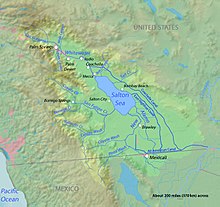
Back Saltonmeer Afrikaans بحر سالتون Arabic Солтън Си Bulgarian Salton more BS Llac Salton Catalan Salton Sea CEB دەریای ساڵتن CKB Saltonské moře Czech Солтон-Си CV Saltonsee German
| Salton Sea | |
|---|---|
 | |
| Location | Colorado Desert Imperial and Riverside Counties, California, U.S. |
| Coordinates | 33°18′47″N 115°50′04″W / 33.31306°N 115.83444°W |
| Type | Endorheic rift lake |
| Primary inflows | Alamo River New River Whitewater River |
| Primary outflows | None |
| Catchment area | 8,360 sq mi (21,700 km2) |
| Basin countries | Mexico and United States |
| Surface area | 318.0 sq mi (823.6 km2) |
| Max. depth | 43 ft (13 m) |
| Water volume | 6,000,000 acre⋅ft (7.4 km3) |
| Surface elevation | −236 ft (−71.9 m) (below sea level) |
| Settlements | Bombay Beach, Desert Beach, Desert Shores, Salton City, Salton Sea Beach, North Shore |
| References | U.S. Geological Survey Geographic Names Information System: Salton Sea |

The Salton Sea is a shallow, landlocked, highly saline endorheic lake in Riverside and Imperial counties at the southern end of the U.S. state of California. It lies on the San Andreas Fault within the Salton Trough, which stretches to the Gulf of California in Mexico. The lake is about 15 by 35 miles (24 by 56 km) at its widest and longest. A 2023 report put the surface area at 318 square miles (823.6 km2).[1] The Salton Sea became a resort destination in the 20th century, but saw die-offs of fish and birds in the 1980s due to contamination from farm runoff, and clouds of toxic dust in the current century as evaporation exposed parts of the lake bed.
Over millions of years, the Colorado River had flowed into the Imperial Valley and deposited alluvium (soil), creating fertile farmland, building up the terrain, and constantly moving its main course and river delta. For thousands of years, the river alternately flowed into the valley or diverted around it, creating either a salt lake called Lake Cahuilla or a dry desert basin, respectively. When the river diverted around the valley, the lake dried completely, as it did around 1580. Hundreds of archaeological sites have been found in this region, indicating possibly long-term Native American villages and temporary camps.
The modern lake was formed from an inflow of water from the Colorado River in 1905. Beginning in 1900, an irrigation canal was dug from the Colorado River to provide water to the Imperial Valley for farming. Water from spring floods broke through a canal head-gate, diverting a portion of the river flow into the Salton Basin for two years before repairs were completed. The water in the formerly dry lake bed created the modern lake.
During the early 20th century, the lake would have dried up, except that farmers used generous amounts of Colorado River water for irrigation and let the excess flow into the lake. In the 1950s and into the 1960s, the area became a resort destination, and communities grew with hotels and vacation homes. Birdwatching was also popular as the wetlands were a major resting stop on the Pacific Flyway. In the 1970s, scientists issued warnings that the lake would continue to shrink and become more inhospitable to wildlife. In the 1980s, contamination from farm runoff promoted the outbreak and spread of wildlife diseases. Massive die-offs of the avian populations have occurred, especially after the loss of several species of fish on which they depend. Salinity rose so high that large fish kills occurred, often blighting the beaches of the sea with their carcasses. Tourism was drastically reduced.
After 1999, the lake began to shrink as local agriculture used the water more efficiently, so less runoff flowed into the lake. As the lake bed became exposed, the winds sent clouds of toxic dust into nearby communities. The state is mainly responsible for fixing the problems. California lawmakers pledged to fund air-quality management projects in conjunction with the signing of the 2003 agreement to send more water to coastal cities. Local, state and federal bodies all had found minimal success dealing with the dust, dying wildlife, and other problems for which warnings had been issued decades before. In 2017, the Salton Sea Management Program was developed by the state. The Torres Martinez Desert Cahuilla Indians partnered with the state to restore shallow wetlands along the northern edge of the sea in 2018. Construction began in 2021 on a 4,110-acre (1,660 ha) habitat restoration and dust suppression project.

